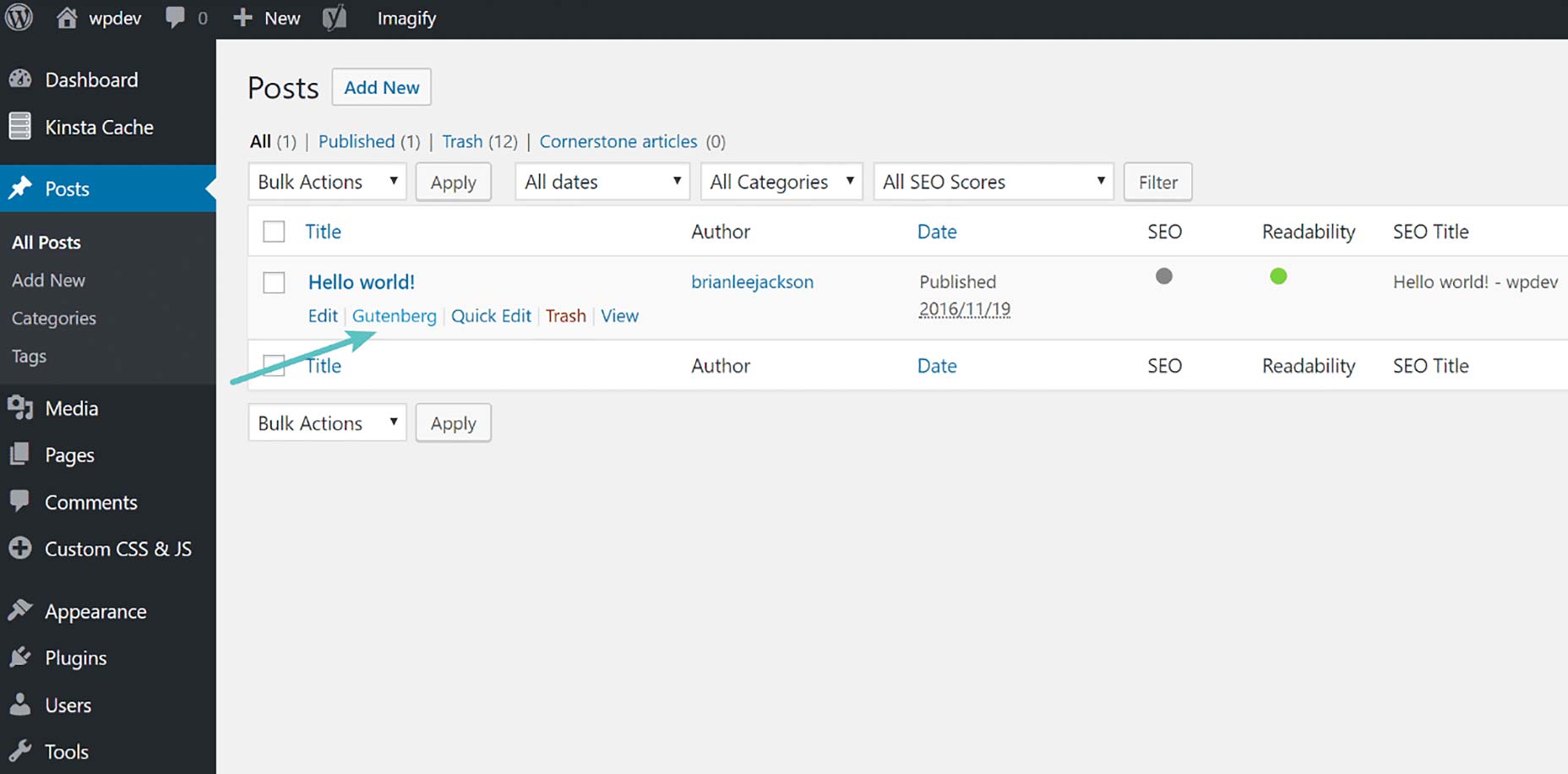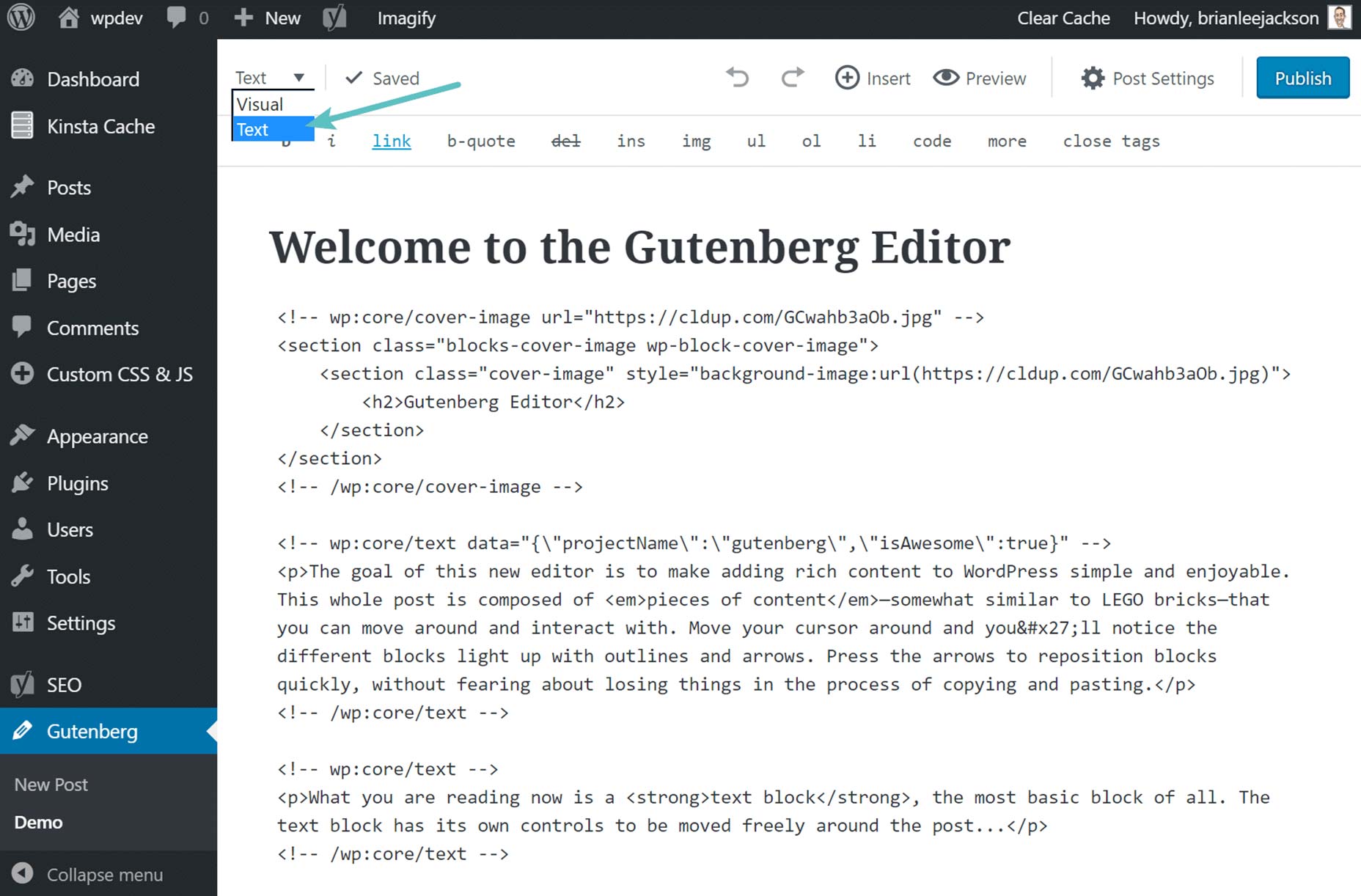
What is Gutenberg?
Gutenberg is a take on the new editor for WordPress. It is named after Johannes Gutenberg, who is credited with popularizing moving type. (As a mini history lesson, moveable type was actually invented in China by Bi Sheng.) The current visual editor requires the knowledge of shortcodes and HTML for full functionality, and was really only ever a partial WYSIWYG editor. With Gutenberg, WordPress core contributors had the goal of making things easier for users through the use of “little blocks”, or small sections that you can edit, one at a time, so that it isn’t overwhelming to make changes that could affect the entire page as a whole. It’s been said that Gutenberg was created with functionality similar to Medium in mind, allowing the user to easily edit these blocks as changes are needed. The blocks can be moved up and down or deleted, as with other popular page builders on the market. Importantly, this block feature scales well with mobile. For WordPress users that are used to the text editor, you can switch between the visual and text editor by using drop down menu located at the top left of the page. However, as you can probably imagine, switching to the new text editor adds more clutter to work around. Here’s the official example of the front-end results of using Gutenberg’s editor.The Gutenberg Plugin
According to Matt Mullenweg on his website, the motivation behind the Gutenberg plugin is:Theme developers won’t need to bundle tons of plugins or create their own page builders. There’ll be a standard, portable way to create rich layouts for posts and guide people setup right in the interface, no 20-step tutorials or long videos needed. Every theme will be able to compete with multi-functional premium themes without locking users into a single theme or compromising their experience.Gutenberg is currently in the beta testing phase. The current iteration will work for WordPress version 4.8 and above. As of this writing, Gutenberg is offered as a plugin, but developers are working hard to ensure that it will be ready to be included in the next core Wordpress 4.9 update. Being perhaps a bit more realistic, Gutenberg likely won’t be included in the WordPress core code until version 5.0 is released. Matt Mullenweg is hoping to get 100,000 active installs for the current plugin, and is actively encouraging people to leave all feedback on the WordPress support forum. There’s also the new challenge of abandoning React and having to rewrite the Gutenberg plugin because of a challenging patents clause. Since being offered to the public, as of this writing, Gutenberg has 2,000+ active installs and a 2.5 star rating. It’s safe to say that there’s a long way to go for Mullenweg to hit his desired numbers, and to win more of the WordPress community over to Gutenberg.
What Gutenberg Looks Like in Action
If you want to test out Gutenberg, it is recommended to use a test site or using your host’s staging environment. When Gutenberg is installed on WordPress, the options under each post will look like this: Gutenberg still hasn’t replaced the ‘Edit’ button, so users can test the difference between how the two work. Gutenberg also adds a new option on the sidebar menu, which allows you to try a demo and includes the ability to create a new post.
Gutenberg has the ability to switch between the visual editor mode and Text Editor (code/HTML). There are HTML comments at the beginning and end of each text block, which allow you to create text blocks directly from the text editor if you’re not used to the visual mode.
This feature represents a significant and important change over the typical page builder. With most page builders, you essentially have to rebuild each page if you switch to a new theme or design incompatible with the page builder. With Gutenberg, reverting blocks to HTML is a standard option that reduces work over the long term.
Gutenberg still hasn’t replaced the ‘Edit’ button, so users can test the difference between how the two work. Gutenberg also adds a new option on the sidebar menu, which allows you to try a demo and includes the ability to create a new post.
Gutenberg has the ability to switch between the visual editor mode and Text Editor (code/HTML). There are HTML comments at the beginning and end of each text block, which allow you to create text blocks directly from the text editor if you’re not used to the visual mode.
This feature represents a significant and important change over the typical page builder. With most page builders, you essentially have to rebuild each page if you switch to a new theme or design incompatible with the page builder. With Gutenberg, reverting blocks to HTML is a standard option that reduces work over the long term.

Gutenberg: The Bad
The 2.5-star rating on the Gutenberg plugin demonstrates that a lot of people aren’t happy with it quite yet. Here’s a sampling from reviews so far:- Gutenberg will make copy-pasting difficult
- Changing a line of text into a header will take two actions instead of one
- Media handling isn’t that good: image editing is limited and video embedding isn’t that good
- Makes WordPress more complicated than it has to be
- Disappointing page and post editing capabilities
- How will the drop cap function be needed in blocks of text?
- What is the point of the gear in the top-right corner of every block?
- Why did they bother with the Latest Posts widget?
Gutenberg: The Good
Though the WordPress community as a whole seems to have a major vendetta against Gutenberg, reviews aren’t all bad. First off, people appreciate that it’s an attempt at distraction-free writing. If you put the current visual editor and Gutenberg side by side, you’ll see that Gutenberg has more physical space for writing. In general, users believe that it’s a good move as it’s a step towards the next evolution of WordPress. Gutenberg’s functionality is better geared to the beginner than the current visual editor. Good reviews of the Gutenberg plugin say:- It is good for building blocks and for block editing
- Makes tables and lists easy to make and manage
Gutenberg is an important conceptual step forward for WordPress. Gutenberg enables WordPress to build content layouts, not just write articles. It is one of many transitions happening in WordPress toward a more simplified user experience.Although Gutenberg is still in beta, and has only had 2,000 active installs, there’s certainly a lot of room for improvement. At the time of writing, there are only 139 reviews, which represents a very small percentage of users.
How Gutenberg is Going to Affect Page Builder Plugins
Gutenberg plugin early reviewers think that Gutenberg should be offered as a plugin only, and not as an innate WordPress theme feature. Should WordPress make Gutenberg an integrated feature, WordPress users will be divided. Should WordPress make the necessary improvements to Gutenberg, it will challenge the existing page builders and eliminate the need for them. After all, why pay extra or take the time to learn something new with functionality that will likely become innate to WordPress? Furthermore, as discussed earlier, one of the main issues with page builder plugins right now is that if you want to install a new theme from a different provider, you have to completely rebuild pages if you don’t continue to use the same page builder. Another segment of WordPress users will probably complain, because they like the flexibility WordPress brings, which includes the choice to use plugins that they’re already used to. At any rate, it will be interesting to see how page builders adapt and create solutions, perhaps focusing on the unique functionalities that they’ve built out over time.Will Gutenberg Kill the Page Builder Industry?
The idea behind Gutenberg is pure, starting from a clamoring of WordPress users that called for an update on the CMS’s outdated visual editor. However, since being announced, Gutenberg has received a number of mixed reviews—mostly negative, with many people calling for it to be offered as an optional plugin instead of a core part of the new WordPress update. Gutenberg is still new and has plenty of room to improve because of it’s nature as a work in progress. The implications for the page builder industry have yet to be fully realized, but if it ends up being included as part of the core update, they should definitely be scared for their futures.Maddy Osman
Maddy Osman creates engaging content with SEO best practices for marketing thought leaders and agencies that have their hands full with clients and projects. Learn more about her process and experience on her website, www.The-Blogsmith.com and read her latest articles on Twitter: @MaddyOsman.
Read Next
15 Best New Fonts, July 2024
Welcome to our monthly roundup of the best fonts we’ve found online in the last four weeks. This month, there are fewer…
By Ben Moss
20 Best New Websites, July 2024
Welcome to July’s round up of websites to inspire you. This month’s collection ranges from the most stripped-back…
Top 7 WordPress Plugins for 2024: Enhance Your Site's Performance
WordPress is a hands-down favorite of website designers and developers. Renowned for its flexibility and ease of use,…
By WDD Staff
Exciting New Tools for Designers, July 2024
Welcome to this July’s collection of tools, gathered from around the web over the past month. We hope you’ll find…
3 Essential Design Trends, July 2024
Add some summer sizzle to your design projects with trendy website elements. Learn what's trending and how to use these…
15 Best New Fonts, June 2024
Welcome to our roundup of the best new fonts we’ve found online in the last month. This month, there are notably fewer…
By Ben Moss
20 Best New Websites, June 2024
Arranging content in an easily accessible way is the backbone of any user-friendly website. A good website will present…
Exciting New Tools for Designers, June 2024
In this month’s roundup of the best tools for web designers and developers, we’ll explore a range of new and noteworthy…
3 Essential Design Trends, June 2024
Summer is off to a fun start with some highly dramatic website design trends showing up in projects. Let's dive in!
15 Best New Fonts, May 2024
In this month’s edition, there are lots of historically-inspired typefaces, more of the growing trend for French…
By Ben Moss
How to Reduce The Carbon Footprint of Your Website
On average, a web page produces 4.61 grams of CO2 for every page view; for whole sites, that amounts to hundreds of KG…
By Simon Sterne
20 Best New Websites, May 2024
Welcome to May’s compilation of the best sites on the web. This month we’re focused on color for younger humans,…














